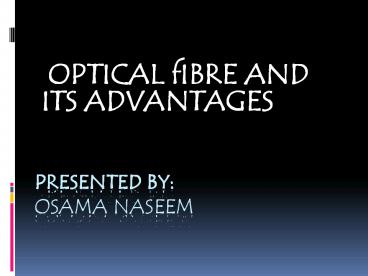Introduction to Optical Fibre Presentation - PowerPoint PPT Presentation
Title:
Introduction to Optical Fibre Presentation
Description:
Opical fibre and its advantages. Hope! you'll like it. Give feedback. – PowerPoint PPT presentation
Number of Views:238
Title: Introduction to Optical Fibre Presentation
1
Presented byosama naseem
- OPTICAL fIBRE AND ITS ADVANTAGES
2
Table of contents
- What is OPTICAL FIBRE?
- Evolution of OPTICAL FIBRE
- Components of OPTICAL FIBRE
- Total Internal Reflection
- How OPTICAL FIBRE works?
- Types of OPTICAL FIBRE
- Advantages and Disadvantages of OPTICAL FIBRE
3
What is OPTICAL FIBRE?
- Fiber optics (optical fibers) are long, thin
strands of very pure glass about the diameter of
a human hair. - They are arranged in bundles called optical
cables and used to transmit light signals over
long distances.
4
EVOLUTION OF OPTICAL FIBRE
- 1880 Alexander Graham Bell
- 1930 Patents on tubing
- 1950 patents for two layer glass wave guide
- 1960 Laser first used as alight source
- 1965 High loss of light discovered
- 1970 Refining of manufacturing process
- 1980 OPTICAL FIBRE becomes backbone of long
distance telephone networks
5
COMPONENTS OF OPTICAL FIBRE
- CORE thin glass centre where the light
travels. - CLADDING outer optical material that surrounds
the core. - BUFFER COATING plastic coating that protects
the fibre.
6
DIAGRAM
7
TOTAL INTERNAL REFLECTION (TIR)
- To understand how optical fibre works we have
to understand the concept of TIR. - When the angle of incidence becomes larger than
the critical angle, no refraction occur. The
entire light is reflected back into the denser
medium. This is known as TOTAL INTERNAL
REFLECTION.
8
DIAGRAM OF TIR
9
HOW OPTICAL FIBRE WORKS?
- Light that enters the core at one end of the
optical fibre goes straight and hits the inner
wall(cladding) of fibre optics. The angle of
incidence with cladding is greater than the
critical angle, light is totally reflected into
the fibre optics until it hits the inner wall
again, and so on. - As explained above, this phenomena is TOTAL
INTERNAL REFLECTION.
10
DIAGRAM
11
TYPES OF OPTICAL FIBRE
- There are two basic types of optical fibre.
- SINGLE MODE FIBRE
- MULTI-MODE FIBRE
12
SINGLE MODE FIBRE
- Single mode fiber is optical fiber that is
designed for the transmission of a single ray or
mode of light as a carrier . - It is used for long-distance signal transmission.
- This fibre is used in telecom and CAT V networks.
13
DIAGRAM
14
MULTI-MODE FIBRE
- Each optical fibre in a multi-mode cable is about
10 times thicker than fibre optics used in a
single mode cable. This means light beams can
travel through the core by following different
paths,hence the name multi-mode. - Multi-mode cable can send information only over
relatively short distances and are used to link
computer networks together.
15
DIAGRAM
16
ADVANTAGES
- Bandwidth - Fibre optic cables have a much
greater bandwidth than copper cables. The amount
of information that can be transmitted per unit
time of fibre over other transmission media is
its most significant advantage. - Low Power Loss - An optical fibre offers low
power loss. In comparison to copper in a
network, the longest recommended copper distance
is 100m while with fibre, it is 2000m.
17
- Interference - Fibre optic cables are immune to
electromagnetic interference. It can also be run
in electrically noisy environments without
concern as electrical noise will not affect
fibre. - Size - In comparison to copper, a fibre optic
cable has nearly 4.5 times as much capacity as
the wire cable has and a cross sectional area
that is 30 times less. - Weight - Fibre optic cables are much thinner and
lighter than metal wires. They also occupy less
space with cables of the same information
capacity. Lighter weight makes fibre easier to
install.
18
- Safety - Since the fibre is a dielectric, it does
not present a spark hazard. - Security - Optical fibers are difficult to
tap. fibre is the most secure medium available
for carrying sensitive data. - Flexibility - An optical fibre has greater
tensile strength than copper or steel fibers of
the same diameter. It is flexible, bends easily
and resists most corrosive elements that attack
copper cable.
19
DISADVANTAGES
- Cost - Cables are expensive to install but last
longer than copper cables. - Transmission - Transmission on optical fiber
requires repeating at distance intervals.
20
- Fragile - Fibers can be broken or have
transmission loses when wrapped around curves of
only a few centimeters radius. However by
encasing fibers in a plastic sheath, it is
difficult to bend the cable into a small enough
radius to break the fiber.
21
- Thank You
- Any Question?































